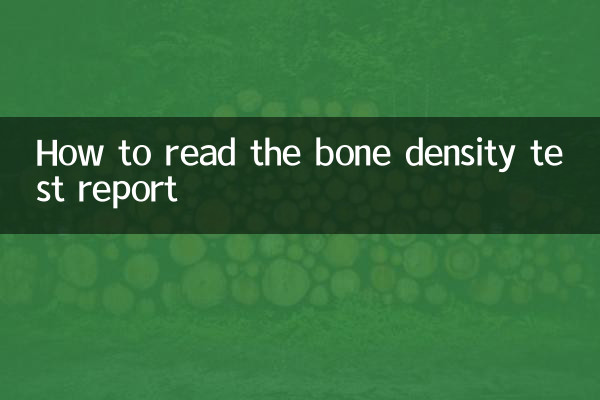How to read the bone density test report
In recent years, with the improvement of health awareness, bone density testing has gradually become a routine examination item for middle-aged and elderly people and people at high risk of osteoporosis. However, many people are confused by the data and terminology in the bone density test report after receiving it. This article will explain in detail how to interpret a bone density test report to help you better understand your bone health.
1. What is bone density testing?

Bone Mineral Density Test is an examination method used to measure the mineral content in bones. It is mainly used to diagnose osteoporosis and assess the risk of fractures. Common detection methods include dual-energy X-ray absorptiometry (DXA) and quantitative computed tomography (QCT).
2. Key indicators of bone density test report
Bone density test reports usually include the following key indicators:
| Indicator name | meaning | normal range |
|---|---|---|
| T value | Comparison with average bone density in healthy young adults | ≥ -1.0 |
| Z value | Comparison with the average bone density of peers | ≥ -1.0 |
| BMD (bone density value) | Mineral content in bones (g/cm²) | Varies by site and instrument |
3. How to interpret T value and Z value?
1.T value: T value is the main basis for diagnosing osteoporosis. According to the standards of the World Health Organization (WHO), T-scores are classified as follows:
| T value range | Diagnosis results |
|---|---|
| ≥ -1.0 | Normal bone mass |
| -1.0 to -2.5 | Osteopenia (low bone mass) |
| ≤ -2.5 | osteoporosis |
| ≤ -2.5 with fracture | severe osteoporosis |
2.Z value: The Z-score is mainly used to evaluate whether the bone density is consistent with that of peers. If the Z value is too low (usually <-2.0), it may indicate the presence of secondary osteoporosis or other bone diseases and further examination is required.
4. Precautions for bone density testing
1.Detection site: Common testing sites include the lumbar spine, hip, and forearm. The bone density values of different parts may be different, and the doctor will make a comprehensive judgment based on the specific situation.
2.Detection frequency: For people at high risk of osteoporosis, it is recommended to conduct a bone density test every 1-2 years; for patients who have been diagnosed with osteoporosis, they need to be reviewed regularly according to their treatment status.
3.Factors affecting the results: Certain drugs, diseases or lifestyle habits (such as long-term use of hormones, hyperthyroidism, smoking, etc.) may affect the results of bone density testing. You should inform your doctor before testing.
5. How to improve bone health?
If your bone density test shows osteopenia or osteoporosis, you can take the following steps to improve your bone health:
| measures | Specific methods |
|---|---|
| Supplement calcium and vitamin D | The recommended daily calcium intake is 1000-1200mg, and the recommended vitamin D intake is 400-800IU. |
| moderate exercise | Weight-bearing exercise (such as walking, jogging) and resistance training can help strengthen bones |
| avoid bad habits | Quit smoking, limit alcohol consumption, and reduce caffeine intake |
| drug treatment | Use anti-osteoporosis drugs (such as bisphosphonates, estrogen, etc.) under the guidance of a doctor |
6. Summary
The bone density test report is an important tool for assessing bone health. By understanding key indicators such as T-score, Z-score and BMD, you can better understand your bone condition. If the test result is abnormal, you should seek medical treatment promptly and take intervention measures under the guidance of a doctor. At the same time, maintaining good living habits and regular testing are effective ways to prevent osteoporosis.

check the details

check the details